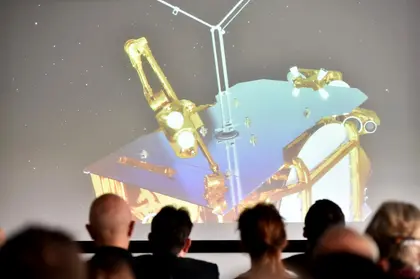The INSCIENCE conference held in Kyiv was a chance for aspiring scientists, technologists and start-up entrepreneurs to exchange ideas and build new initiatives across Ukraine.
“And there are our penguins!” exclaimed the base commander, pointing into the distance. The birds were little black spots on the horizon, but there was indeed a small colony of penguins.
JOIN US ON TELEGRAM
Follow our coverage of the war on the @Kyivpost_official.
Across the internet, the audience was enthralled and fascinated by this live broadcast from the Ukrainian Antarctic Akademik Vernadsky station in Antarctica, direct to Kyiv.
What followed was a guided tour of the base, its science program and the facilities, including the homely wood-paneled bar built when Vernadsky Station was once the British Faraday Station (It is not commonly known that there is a long and friendly link between Ukrainian and British efforts in Antarctica).
From the penguins to the microbes that inhabit the frigid ocean, Vernadsky Station, named after the famed first President of the National Academy of Sciences of Ukraine, carries out a diverse research program to understand this mysterious continent.
The polar tour was one of the highlights of the three-day conference called INSCIENCE, the largest popular science conference in Ukraine. The inspiring women-run organization of the same name had planned the gathering which brings together scientists, technologists and entrepreneurs at the cutting edge of new start-ups across Ukraine.
I was exhilarated by the event and the immense variety of projects. The days rolled effortlessly through artificial intelligence, medical advances, computer technology and software developments.
Delivered in a format of keynote talks and panel discussions, we really got into the detail, but heard from the people themselves, the panels bringing out the more human aspects of the challenges and personal decisions and commitments needed to set up novel commercial enterprises.
Running in parallel was the Science Kids zone, a conference for children, with talks and activities to inspire them.
Of course, it hardly needs to be said that it is especially impressive that such a vibrancy of activity and ideas is being maintained under the shadow of the full-scale invasion.
From that point of view, the conference itself was a remarkable achievement. Each day was in a different location. Anyone who has organized a conference knows the quantity of work involved in planning a one-day meeting, let alone doing this in three different places on three successive days.
The INSCIENCE organization has spawned a range of other initiatives to encourage women into science and to use science and technology to improve the welfare of people in Ukraine. It has become an engine of energy and enterprise in the Ukrainian technical landscape.
My own talk followed the tour of Vernadsky station, and I have to say, it was a hard act to follow. However, it was well planned by the organizers, since I was able to continue the discourse about life in Antarctica with some thoughts about how we might look for life in the extremes of other planets and why we would care about doing this at all.
The science and technology behind the study of distant worlds can help us improve life on Earth, for example, by helping us to find hardy microbes that can facilitate important industrial processes such as mining or recycling waste.
The conference is a unique creature. I’ve been to many academic science meetings in my career and sometimes to commercial meetings focused on industrial technology. But I’ve never seen science and commerce added to a mixing bowl and heartily stirred together into an inseparable dough.
It worked well, leaving the mind invigorated.
In little gatherings in lunch breaks and on the sidelines, schemes flowed back and forth from technologists to businesspeople and from these exchanges new inventions will sprout.
Nowadays, a vast stream of data flows from society and it is unsurprising that there is a great deal of work going on in design, data analysis, machine learning, artificial intelligence, and all those fields that can find ways to process, make sense of, and apply this deluge of information. Presentations and panels explored the ways in which Ukrainian start-ups are taking advantage of these vistas and bringing them to bear on solving challenges in health care, medical developments and agriculture.
There is much overlap in the objectives of people using large datasets. Bringing them together for a few days is an effective way to keep everyone up to date on developments and to encourage the cross-pollination of ideas. Perhaps completely new companies will emerge from those conversations.
I’m a space enthusiast, so I was especially interested in a Ukrainian start-up called MySat which has built an ingenious model of a ‘cubesat’ – small square satellites now being routinely launched into space.
Their educational version allows the user to practice building such a satellite, giving it commands and sensors as might exist on a real satellite bound for space. Perhaps from this original device may come the next generation of Ukrainian space scientists and engineers who will use their experience with this clever simulacrum of a satellite to launch a variety of real missions into space.
What struck me most profoundly during the meeting was the way in which Ukraine’s youth have been both stoic and optimistic in the face of the full-scale invasion. We were treated to a panel discussion in which medical innovations on the front line were being used to improve blood transfusion in hundreds of soldiers every day, and to ensure their success.
The panel, doctors at the beginning of their careers, deeply impressed me with their sheer professionalism.
These were people who, a few years ago, would have been just another batch of medical students like any around the world, learning, enjoying their university days, taking exams. But circumstances called them to save the lives of their fellow citizens, taking existential risks at the front line.
The way they described their work, the advances they had accomplished and the casual mention that one day they might have the chance to write scientific papers describing how they had developed blood transfusion methods on the battlefield left me humbled.
In fact, to widen the point, I was staggered by the quality, sincerity, serious-mindedness, yet gentleness of young Ukrainians when confronted by the current situation. Yet through all this, their capacity for creativity, bright ideas and enthusiasm for their own ventures and the thrill of setting up companies was undimmed.
By the end of the first day, I’ll be honest, as I stood up on the grandly named “main stage,” I felt a little unworthy against those who had trod the boards in the previous hours. But I was also touched by the welcome and interest in the subject about which I spoke. And, of course, I did get to test out some of my very poor Ukrainian, learned in evening classes in Edinburgh.
As a bonus, a folk band turned up at the end of the day and expected participation.
I left the conference with the unexpected benefit of not merely some new fascinating insights in science and technology, but with some rudimentary skills in Ukrainian folk dancing, with which I might have to surprise and astonish my friends when I get a chance.
Science and technology in Ukraine are safe with the next generation. If Ukraine will give the reins of scientific and technical power to its youth, they will do astonishing things. Of that, there is no doubt.
The views expressed in this opinion article are the author’s and not necessarily those of Kyiv Post.
You can also highlight the text and press Ctrl + Enter



